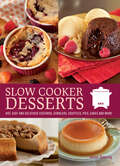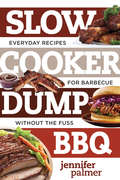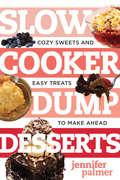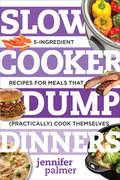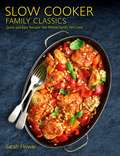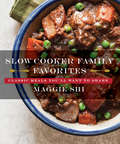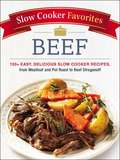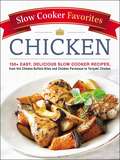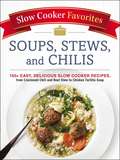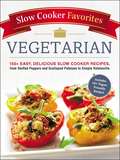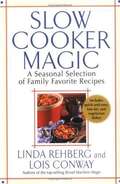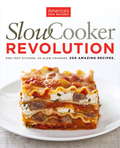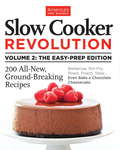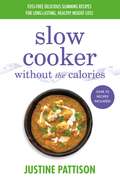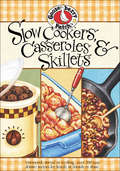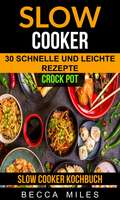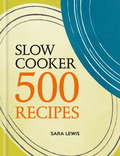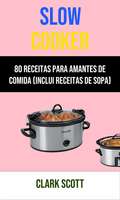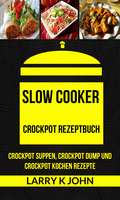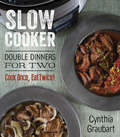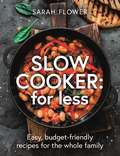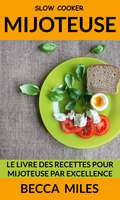- Table View
- List View
Slow Cooker Desserts: Hot, Easy, and Delicious Custards, Cobblers, Souffles, Pies, Cakes, and More
by Jonnie DowningEnjoy no-fuss, hot and scrumptious desserts with this collection of slow cooker recipes by the author of Holiday Slow Cooker.Discover the hassle-free way to have the most delicious desserts. All you have to do is toss the ingredients in your slow cooker and let them cook while you enjoy a relaxing dinner. When it’s time for dessert, you’ll have a piping hot treat ready to serve your family—just don’t forget to top it off with a scoop of ice cream!Slow Cooker Desserts has everything from puddings and crisps, to brownies, cakes, and much more—including:•Super-simple slow cooker cheesecake•Carrot Cake with Cream Cheese Icing•Peach Cobbler•Bananas Foster•Bourbon Custard with Nutmeg•Sticky Toffee Pudding•Coconut Rice Pudding•Rich Bread Pudding with Candied Cherries•Macaroon Brownie Bars•Apple Cranberry Compote•Raspberry Chocolate Casserole•Luscious Lemon Cake•Chocolate Chip Peanut Butter Bars•Brownie Pudding Cake
Slow Cooker Dump BBQ: Everyday Recipes for Barbecue Without the Fuss (Best Ever)
by Jennifer PalmerThe surprise secret use for a slow cooker is authentic-tasting barbecue—without the work Everyone knows that the slow cooker breaks down tough meat into mouth-watering, meltingly delicious dinners. With the right spices, sauces, and rubs, as well as a bit of secret sauce (liquid smoke), chicken, beef, pork, and more mimic their grilled counterpart—without the need to stand over a hot fire, worried as much about overcooking as undercooking. Dump everything in the crockpot and let time and the moist heat do the rest. These recipes boast five ingredients or less, from favorite mains to classic sides, including: Honey-Glazed Baby Back Ribs Barbecue and Cola Ribs Pulled Pork and Avocado Bowl Smoky Glazed Chicken Slow Cooker Bacon Baked Beans Go ahead and indulge in easy, no-fuss recipes the whole family will enjoy.
Slow Cooker Dump Desserts: Cozy Sweets and Easy Treats to Make Ahead (Best Ever)
by Jennifer PalmerSweet slow cooker! Make dessert ahead of time and keep it warm and gooey for serving. Nothing says home like warm, gooey chocolate lava cake. The moist heat of a slow cooker is perfect for cooking and serving cakes, puddings, cobblers, and more. These recipes are made for busy people, so it’s a matter of dumping in a few ingredients and letting the pot do all the work. Come home to delicious, sweet treats that you can serve to even the most discerning guest. Mouthwatering recipes include: Apple-Cinnamon Cobbler Red Velvet Cake Sweet Cinnamon Rolls Pumpkin-Spice Cake with Cream Cheese Frosting Warm Brownie Pudding Pie Fix it and forget it, for a party or any time!
Slow Cooker Dump Dinners: 5-Ingredient Recipes for Meals That (Practically) Cook Themselves (Best Ever)
by Jennifer PalmerBusy moms and dads will appreciate these quick, simple, classic recipes, all of which can be popped into a slow-cooker early in the day so it's ready to eat by the time everyone is home from school and work. Getting a nutritious dinner on the table is one of the top everyday challenges for most families--busy cooks are always eager for healthy, quick, and delicious options that their families will eat. Slow Cooker Dump Dinners offers 50 recipes for hot, homemade meals that can be made by "dumping" a few ingredients into a slow-cooker. And the best part? Each dump dinner is made with just 5 ingredients or less! Talk about quick and easy!
Slow Cooker Family Classics: Quick and Easy Recipes the Whole Family Will Love
by Sarah FlowerA beautifully illustrated book containing nearly 100 delicious slow cooker recipes the whole family will loveThis book contains 100 delicious recipes developed specifically with your family's needs in mind to enable you to use your slow cooker to its maximum potential. The dishes in this book have delighted families for generations, and will make sure even the fussiest of eaters are satisfied. Whether you've got a four-hour slot between picking up the kids or ten minutes in the morning before you head off to work to prepare something, these recipes fit around your busy lifestyle.Sarah Flower is a nutritionist and the author of Slow Cook, Fast Food and The Healthy Slow Cooker Cookbook. Her books have sold more than 300,000 copies.
Slow Cooker Family Classics: Quick and Easy Recipes the Whole Family Will Love
by Sarah FlowerA beautifully illustrated book containing nearly 100 delicious slow cooker recipes the whole family will loveThis book contains 100 delicious recipes developed specifically with your family's needs in mind to enable you to use your slow cooker to its maximum potential. The dishes in this book have delighted families for generations, and will make sure even the fussiest of eaters are satisfied. Whether you've got a four-hour slot between picking up the kids or ten minutes in the morning before you head off to work to prepare something, these recipes fit around your busy lifestyle.Sarah Flower is a nutritionist and the author of Slow Cook, Fast Food and The Healthy Slow Cooker Cookbook. Her books have sold more than 300,000 copies.
Slow Cooker Family Favorites: Classic Meals You'll Want to Share
by Maggie ShiOld school favorites--snacks, sides, mains, sweets, and more--adapted for the slow cooker Slow cooker food conjures images of meat and potatoes--using a different sauce every day doesn't hide the fact that it's pot roast again. But who has time for incredibly complex recipes with dozens of ingredients? Home cooks can take back the slow cooker with these midcentury family favorites, updated for today's tastes and adapted to make ahead of time and cook all day. With an eye toward entertaining, these recipes come together in a flash with zero time spent standing over the stove. Artichoke Red Pepper Dip Molasses Baked Beans Brown Sugar Cider Ham Banana Caramel Cake Spicy Hot Chocolate There's a recipe for any occasion--from weeknight dinners to impromptu parties to festive holiday meals--and they will please even the pickiest eater.
Slow Cooker Favorites Beef: 150+ Easy, Delicious Slow Cooker Recipes, from Meatloaf and Pot Roast to Beef Stroganoff (Slow Cooker Favorites)
by Adams MediaThe go-to family meal guide to prepare tasty, satisfying beef dishes in the slow cooker with more than 150 recipes sure to please anyone—making dinner hassle-free and deliciously diverse every night.Beef is a hearty dinnertime staple and an easy family favorite, and there are countless ways to prepare it. Slow Cooker Favorites Beef will make dinner even easier and more delicious with 150 different recipes you can try—with minimal prep work and easy clean up that’s perfect for your busy schedule. With a wide range of flavors to choose from, classics such as Yankee Pot Roast and French Dip Sandwiches to more exotic dishes like Beef Biryani, you’ll always have something new and savory to try for dinner.
Slow Cooker Favorites Chicken: 150+ Easy, Delicious Slow Cooker Recipes, from Hot Chicken Buffalo Bites and Chicken Parmesan to Teriyaki Chicken (Slow Cooker Cookbook Series)
by Adams MediaLearn how to make easy, affordable, and deliciously diverse dinners for your family every night with this go-to cookbook featuring more than 140 slow-cooker chicken recipes.Chicken is a dinnertime staple. It&’s a simple, budget-friendly favorite, and there are countless ways to prepare it. In Slow Cooker Favorites Chicken you&’ll find something new and delicious to enjoy every day—from classic appetizers and comforting dishes to exotic international one-pot meals—with minimal prep work and easy cleanup. The most challenging part will be picking which dish you want to try next!
Slow Cooker Favorites Soups, Stews, and Chilis: 150+ Easy, Delicious Slow Cooker Recipes, from Cincinnati Chili and Beef Stew to Chicken Tortilla Soup
by Adams MediaA one-stop guide for using the most popular kitchen appliance—the slow cooker—to easily prepare hearty, comforting soups, stews, and chilis. With more than 150 recipes, slow-cooker fans have plenty of options for easy, worry-free ways to make flavorful bowls of their favorite food in their favorite appliance.It’s time to start up the slow cooker! Slow Cooker Favorites: Soups, Stews, and Chilis gives slow-cooker fans more than 150 recipes perfect for the fall and winter. With minimal prep work and easy clean up, the most challenging part will be selecting which delicious bowl to try next. Whether it’s crockpot chili for the tailgate, spicy chicken tortilla soup on a chilly day, or beef stew the whole family will love, there’s something for everyone in this comprehensive collection of crock-pot recipes.
Slow Cooker Favorites Vegetarian: 150+ Easy, Delicious Slow Cooker Recipes, from Stuffed Peppers and Scalloped Potatoes to Simple Ratatouille (Slow Cooker Favorites)
by Adams MediaThe go-to guide for using the most popular kitchen appliance—the slow cooker—to prepare healthy vegetarian dishes, featuring more than 150 easy plant-based and vegan-friendly dishes sure to please everyone at the dinner table.A vegetarian diet is healthy, nutritious, and environmentally friendly. Slow Cooker Favorites Vegetarian makes plant-based eating even easier with more than 150 vegetarian recipes, including more than fifty vegan-friendly recipes, for your slow cooker. Whether you’re a dedicated vegetarian, vegan, or omnivore looking to have more meatless meals, you’ll be sure to find many new and delicious recipes that will become family favorites. With minimal prep work and easy clean up, the hardest part is picking which mouthwatering dish to try next!
Slow Cooker Magic: A Seasonal Selection of Family Favorite Recipes
by Linda Rehberg Lois ConwayOver 100 inventive recipes for year-round family meals including side dishes and desserts from the authors of the top-selling Bread Machine Magic Slow cookers have been one of the hot appliances in every market from Wal-Mart to Williams Sonoma over the last two years. There are loads of slow cooker books on the market, but Conway and Rehberg's book is unique: It demonstrates that slow cookers are useful and ingenious year-round appliances, perfect not just for the soups and stews of winter, but for spring potlucks at school and big family picnics in summer. Slow Cooker Magic includes not just main dishes, such as Chili and Chicken with Gravy, but appetizers, such as Spicy Tortilla Soup, and side dishes, such as Balsamic Glazed Carrots, too. With sidebars and tips that will bring magic to every home cook, Slow Cooker Magic also includes: Sandwiches Vegetarian recipes Desserts New uses for slow cookers. Rehberg and Conway's Bread Machine Magic is a beloved big seller because their exhaustive testing produced recipes that work every time in every type of machine. They shine at giving home cooks fresh ideas to breathe new life into favorite appliances, and have done it again with Slow Cooker Magic.
Slow Cooker Revolution
by America'S Test KitchenThe 200 recipes in this family-friendly collection deliver a revolution in slow cooking like only America's Test Kitchen can! Who doesn't like the idea of throwing ingredients into a slow cooker and coming back hours later to a finished meal? Too bad most slow cooker recipes deliver mediocre results you'd rather forget than fix again. A team of ten test cooks at America's Test Kitchen spent a year developing recipes, and what they discovered will change the way you use your slow cooker.Did you know that onions garlic, and spices should be bloomed in the microwave for five minutes before they go into the slow cooker? This simple step intensifies their flavor and requires no extra work. Did you know that a little soy sauce mixed with tomato paste adds meaty flavors to almost any stew and can often replace the tedious step of browning the meat? And do you know the secret to a moist slow-cooker chicken? Start the bird upside down to protect the delicate white meat from drying out.
Slow Cooker Revolution Volume 2: The Easy-Prep Edition
by America'S Test KitchenVolume 2 brings more slow cooker recipes for your family to enjoy. The test cooks at America's Test Kitchen have worked their magic again, developing and perfecting an all-new collection of 200 slow-cooker recipes. With this volume, we looked at this must-have appliance in new ways to truly maximize its potential. You'll learn how to make a host of dishes like Garlicky Shrimp, Chicken Soft Tacos, and Flourless Chocolate Cake--recipes you'd never expect to see coming out of a slow cooker. The moist heat of the slow cooker is tailor-made to serve up flavorful stews, chilis, and braises (and don't worry--we've included a good number of these), but with our smart strategies and clever ingredient selections, we were also able to pull off spice-rubbed roast chicken, ziti with meaty ragu, rare roast beef, poached salmon and even cheesecake.
Slow Cooker Without the Calories
by Justine PattisonPart of a series of low calorie cookbooks devised by bestselling author and the UK's favourite diet recipe writer, Justine Pattison.SLOW COOKER WITHOUT THE CALORIES takes all the hassle out of eating the low cal way. Justine's thoroughly tested recipes are simple, accessible and imaginative. Her writing experience and clever combinations will make losing weight as easy as 1-2-3! Each delicious slow cooked recipe is supplied with introductions, prep and cook times, calorie counts and additional applicable nutritional information, plus Justine's trademark tips and ideas to support and enhance the cooking experience! Also including a handy guide on how to get the very best out of your slow cooker.
Slow Cooker, Casseroles & Skillets Cookbook
by Gooseberry PatchWe love sharing a home-cooked meal with family & friends, and when time is really short, a scrumptious skillet dinner can be ready in a jiffy. You'll find super-easy recipes like busy-day cheesy chicken, Angie's taco pie and sizzling potato skillet...with just 5 ingredients. You'll have no picky eaters when Judy's easy meatloaf, sloppy joe bake or sweet-and-sour pork chops are on the menu. There are lots of hearty one-pot meals like family favorite pot roast, spicy shrimp noodle bowl and herbed chicken dinner! You'll find lots of easy cooking tips too, plus simple ideas for making mealtime memorable and fun. We predict that this will become your new go-to cookbook for satisfying quick & easy family meals.
Slow Cooker: 30 schnelle und leichte Rezepte (Slow Cooker Kochbuch)
by Becca Miles Caio Lopes de Melo LindosoDas einzige Handbuch über Crock-Pot Schongarer Sie brauchen: Was finden Sie in dem besten Crock-Pot- und Schongarerrezeptbuch? •Eine ausführliche Liste von Zutaten, die Sie brauchen, um in deinem Crock-Pot zu kochen. •Ein etappenweise Handbuch darüber, wie Ihre Mähler in dem Crock-Pot und Schongarer zu kochen. •Eine breite Vielfältigkeit von Speisen, die alle Geschmacken und Präferenze befriedigt. Beeindrucken Sie Familie und Freunde mit den leckeren Schongarerspeisen: The Ultimate Crockpot Cookbook ist angekommen! Da sind Sie! Bereit dazu, leckere Corck-Potrezepte zu kochen! Wollen Sie Ihre Familie, Freunde beeindrucken oder sogar Sich selbst verwöhnen? Ob Sie neu dabei oder ein erfahrener Koch sind, hier finden Sie alle Hilfsmittel, die Sie brauchen, um hervorragende Speisen zu kochen. Stellen Sie sich zu Hause: Sie arbeiten, Sie führen Ihre Aufgabe aus oder kommen Sie zurück, nachdem Sie Ihre Besorgungen gemacht haben: Und als Sie den Flur entlang läuft, können sie das Geruch spüren, das Aroma, die Güte aus der Küche herauskommend: Das ist dein Mahl, das wird langsam in der Küche gegart. Es wartet auf Sie; es will, dass Sie es schmecken. Und Sie wissen, dass nach ein Paar Stunden, wenn alle Ihre Zeuge schon erledigt sind, es ist da für Sie, fertig für Ihren Genuss. Aber am wichtigsten ist es Ihre Erschaffung, es ist Ihres! Benutzen Sie das Wissen der engültigen Schongarerrezepte und der Crock-Potspeisen, um Ihr Leben für immer gesundheitlicher zu verändern! Wir sorgen für Sie: Genießen Sie die gesundsten und leckersten Crock-Potrezepte.
Slow Cooker: 500 Recipes
by Sara LewisDiscover just how versatile a slow cooker can be with the new Slow Cooker: 500 Recipes. With 500 recipes to choose from, this tome of slow cooker recipes will fail to disappoint. Featuring sixteen chapters and packed with delicious recipes, you will find a dish to suit any occassion. All you have to do is leave your ingredients to cook throughout the day or overnight, and there will always be a hot meal waiting for you at the end of a busy day.
Slow Cooker: 500 Recipes
by Sara LewisDiscover just how versatile a slow cooker can be with the new Slow Cooker: 500 Recipes. With 500 recipes to choose from, this tome of slow cooker recipes will fail to disappoint. Featuring sixteen chapters and packed with delicious recipes, you will find a dish to suit any occassion. All you have to do is leave your ingredients to cook throughout the day or overnight, and there will always be a hot meal waiting for you at the end of a busy day.
Slow Cooker: 80 Receitas Para Amantes De Comida (Inclui Receitas De Sopa)
by Clark ScottUma das atrações fundamentais para alguns é a simplicidade de uma slow cooker (panela de cozimento lento), então quando você estiver procurando por receitas, mantenha-se longe daquelas que recomendam uma tonelada de pré-planejamento. Para alguns pratos, especialmente sopas e ensopados, você pode simplesmente jogar cada um dos ingredientes na panela. Pode ser bom cozinhar as cebolas até agora, porém, o sabor é diferente de quando você as coloca no cru, mas teste ambos os pratos para descobrir o seu favorito. Apesar de você poder preparar refeições durante seus dias de folga, para que você só tenha que aquecê-los quando precisar, há algo único em ter comida recém-cozida. O que você pode fazer sobre isso? Como você pode ter certeza que você tem comida caseira quente, fresca sem ter que comprometer horas para sua agenda já ocupada? Este livro contém deliciosas receitas de cozimento lento que podem ser usadas para completar uma refeição, ou para lhe dar ideias sobre onde começar sua própria criação deliciosa! A slow cooker é amada por muitos, pois é uma maneira fácil de criar refeições quentes, saudáveis e deliciosas que você pode usar uma e outra vez. Não espere mais tempo para descobrir a chave para uma vida nova e melhor.
Slow Cooker: Crockpot Suppen, Crockpot Dump und Crockpot Kochen Rezepte
by Larry K John Pablo Muñoz TorresHunderttausende von Menschen auf der ganzen Welt haben die gesundheitlichen Vorteile der Slow Cooking entdeckt und verlieren dieses hartnäckige Bauchfett und senken ihr Risiko für Hunderte von Fettleibigkeit-bedingten Krankheiten. Langsam Kochen ist eine einfache Kochtechnik, die Ihnen erlaubt, versteckte Aromen und Texturen aus Ihrem Essen zu entsperren. Es ist vielseitig und Sie können alle Zutaten kochen, die Sie sich vorstellen können, von den billigsten Schnitten von Fleisch bis zu hochwertigen Filets. Dieses Buch enthält eine breite Palette von Rezepten, von Huhn zu Lamm zu Rindfleisch. Sie sind alle leicht zu Quelle Zutaten und einfach zu kochen, ihre Aromen sind einzigartig und doch ausgewogen und die Rezepte selbst verwenden gerade genug Gewürze, um ein gemeinsames Rezept in eine erstaunliche! Langsame Kochen ist nicht nur effektiv bei der Unterstützung Sie mit Ihrem Gewichtsverlust Ziele, aber unglaublich effektiv bei anderen Dingen wie Muskelaufbau, Managing Gluten Intoleranz und Zöliakie, Reversing Diabetes, die Verringerung der Herzerkrankungen und Krebsrisiken, Senkung des Blutdrucks und die Verringerung der Cholesterin.
Slow Cooker: Double Dinners for Two (Slow Cooking For Two Ser.)
by Cynthia GraubartFrom the James Beard Award–winning author of Slow Cooking for Two comes even more creative, delicious, and easy recipes for your slow cooker. In Slow Cooker Double Dinners for Two, Cynthia Graubart expands her unique concept of using a 3-1/2- or 4-quart slow cooker coupled with slow cooker liner bags, creating two different dinners at the same time. Double dinners produce not only a tasty meal for tonight but also a wonderful second meal for later in the week or for the freezer. Enjoy diverse dishes like Chicken Marsala with Mushrooms and Sage, Rustic Mexican Stew, and Turkey Breast Tenderloin with Cranberry-Orange Sauce. Make them alongside updated traditional favorites like Red Wine Flank Steak, Old-Fashioned Pot Roast, Cherry Balsamic Pork, Vegetarian Chili, and more!
Slow Cooker: Easy, budget-friendly recipes for the whole family
by Sarah FlowerA beautifully illustrated book containing more than seventy delicious slow cooker recipes that are big on flavour and light on your wallet.Developed specifically with your family's needs in mind to help you eat well for less and use your slow cooker to its maximum potential, the nutritious dishes in this book can be cooked for less than £5. They have delighted families for generations, and will make sure even the fussiest of eaters are satisfied with a range of make-at-home 'fakeaways' and delicious desserts.Recipes include Creamy Dahl Soup; Beef Shin Bolognese; Slow Cooked Pork Shoulder; Vegan Bean Stew; Broccoli, Spinach, Cheese and Walnut Crustless Pie; Chicken Chow Mein; and Chocolate Chip Banana Bread.Whether you've got a four-hour slot between picking up the kids or ten minutes in the morning before you head off to work to prepare something, these recipes fit around your busy lifestyle, all for under a fiver.Sarah Flower is a nutritionist and the author of Slow Cook, Fast Food and The Healthy Slow Cooker Cookbook. Her books have sold more than 300,000 copies.
Slow Cooker: Easy, budget-friendly recipes for the whole family
by Sarah FlowerA beautifully illustrated book containing more than seventy delicious slow cooker recipes that are big on flavour and light on your wallet.Developed specifically with your family's needs in mind to help you eat well for less and use your slow cooker to its maximum potential, the nutritious dishes in this book can be cooked for less than £5. They have delighted families for generations, and will make sure even the fussiest of eaters are satisfied with a range of make-at-home 'fakeaways' and delicious desserts.Recipes include Creamy Dahl Soup; Beef Shin Bolognese; Slow Cooked Pork Shoulder; Vegan Bean Stew; Broccoli, Spinach, Cheese and Walnut Crustless Pie; Chicken Chow Mein; and Chocolate Chip Banana Bread.Whether you've got a four-hour slot between picking up the kids or ten minutes in the morning before you head off to work to prepare something, these recipes fit around your busy lifestyle, all for under a fiver.Sarah Flower is a nutritionist and the author of Slow Cook, Fast Food and The Healthy Slow Cooker Cookbook. Her books have sold more than 300,000 copies.
Slow Cooker: Le Livre Des Recettes Pour Mijoteuse par Excellence
by Sylvie Paysac Becca MilesVous n'aurez pas besoin d'autres livres de recettes pour mijoteuse lorsque vous aurez acheté le Livre Des Recettes Pour Mijoteuse par Excellence: Le Livre Des Recettes Pour Mijoteuse par Excellence inclut: * Une liste détaillée des ingrédients nécessaires pour toutes les recettes. * Un guide informatif sur chaque recette pour la mijoteuse. * Des recettes variées pour satisfaire tous les goûts et vos préférences culinaires. Vos amis et votre famille n'en reviendront pas ! Avec le Livre Des Recettes Pour Mijoteuse par Excellence, vous impressionnerez avec vos recettes de repas mijotés. Vous êtes prêt à réaliser de délicieuses recettes à la mijoteuse ! Vous voulez impressionner votre famille, vos amis ou simplement satisfaire vos papilles ? Que vous soyez novice ou un cuisinier expérimenté, vous trouverez tout ce dont vous avez besoin pour préparer d'excellents repas. Imaginez vous à la maison: vous travaillez, vous effectuez vos tâches quotidiennes ou vous rentrez après avoir fait les courses; vous ouvrez la porte de chez vous et un arôme délicieux vous emplit les narines, cette merveilleuse odeur vient de votre cuisine. C'est le repas de ce soir qui cuisez lentement dans votre mijoteuse. Il vous attends. Il vous interpelle. Et vous savez que dans quelques heures, lorsque vous aurez complété vos tâches, il sera prêt. Prêt à être dévoré. Et encore mieux, c'est une de vos créations ! Cet arôme délicieux vous appartient ! Servez vous du Livre Des Recettes Pour Mijoteuse par Excellence pour changer votre vie à tout jamais en créant des recettes différentes et saines pour votre santé! Pensez à votre santé; Appréciez ces recettes pour Mijoteuse, excellentes pour votre santé et pour vos papilles. J'ai sélectionné pour vous toutes ces recettes et j'espère que vous allez les apprécier.
